Volumetric Change Detection in Bedrock Coastal Cliffs Using Terrestrial Laser Scanning and UAS-Based SfM
Abstract
1. Introduction
2. Materials and Methods
2.1. Study Site
2.2. Measurements Using TLS and UAS-SfM
3. Results
3.1. Field Measurement
3.2. Point Cloud Alignments
3.3. Differential Volume Estimate
4. Discussion
4.1. Advantages and Limitations of the Proposed Methodology
4.2. Potential Factors Affecting the Erosion
5. Conclusions
Author Contributions
Funding
Acknowledgments
Conflicts of Interest
References
- Sunamura, T. Geomorphology of Rocky Coasts; John Wiley & Sons: Chichester, UK, 1992. [Google Scholar]
- Naylor, L.A.; Stephenson, W.J.; Trenhaile, A.S. Rock coast geomorphology: Recent advances and future research directions. Geomorphology 2010, 114, 3–11. [Google Scholar] [CrossRef]
- Nicholls, R.J.; Cazenave, A. Sea-level rise and its impact on coastal zones. Science 2010, 328, 1517–1520. [Google Scholar] [CrossRef] [PubMed]
- Bray, M.J.; Hooke, J.M. Prediction of soft-cliff retreat with accelerating sea-level rise. J. Coast. Res. 1997, 13, 453–467. [Google Scholar]
- Trenhaile, A.S. Predicting the response of hard and soft rock coasts to changes in sea level and wave height. Clim. Chang. 2011, 109, 599–615. [Google Scholar] [CrossRef]
- Koike, K. The countermeasures against coastal hazards in Japan. Geo J. 1996, 38, 301–312. [Google Scholar] [CrossRef]
- Lee, E.M. Coastal cliff behaviour: Observations on the relationship between beach levels and recession rates. Geomorphology 2008, 101, 558–571. [Google Scholar] [CrossRef]
- Uda, T. Downcoast erosion triggered by exhaustion of sand supply from sea cliffs: An example of northern Kujukuri Beach in Japan. In Beaches; Cessa, M., Ed.; Nova Science Publishers, Inc.: Hauppauge, NY, USA, 2014; pp. 121–146. ISBN 9781631172397. [Google Scholar]
- Rosser, N.J.; Brain, M.J.; Petley, D.N.; Lim, M.; Norman, E.C. Coastline retreat via progressive failure of rocky coastal cliffs. Geology 2013, 41, 939–942. [Google Scholar] [CrossRef]
- Horikawa, K.; Sunamura, T. Study on recession of sea cliffs using aerial photographs. Annu. J. Coast. Eng. JSCE 1967, 14, 315–324. (In Japanese) [Google Scholar] [CrossRef]
- Dornbusch, U.; Robinson, D.A.; Moses, C.A.; Williams, R.B.G. Temporal and spatial variations of chalk cliff retreat in East Sussex, 1873 to 2001. Mar. Geol. 2008, 249, 271–282. [Google Scholar] [CrossRef]
- Young, A.P.; Guza, R.T.; O’Reilly, W.C.; Flick, R.E.; Gutierrez, R. Short-term retreat statistics of a slowly eroding coastal cliff. Nat. Hazards Earth Syst. Sci. 2011, 11, 205–217. [Google Scholar] [CrossRef]
- Rosser, N.J.; Petley, D.N.; Lim, M.; Dunning, S.; Allison, R.J. Terrestrial laser scanning for monitoring the process of hard rock coastal cliff erosion. Q. J. Eng. Geol. Hydrogeol. 2005, 38, 363–375. [Google Scholar] [CrossRef]
- Obanawa, H.; Hayakawa, Y.S.; Gomez, C. 3D modelling of inaccessible areas using uav-based aerial photography and structure from motion. Trans. Jpn. Geomorphol. Union 2014, 35, 283–294, (In Japanese with English abstract). [Google Scholar]
- Hayakawa, Y.S.; Obanawa, H.; Saito, H.; Uchiyama, S. Geomorphological applications of Structure-from-Motion Multi-View Stereo photogrammetry: A review. Trans. Jpn. Geomorphol. Union 2016, 37, 321–343, (In Japanese with English abstract). [Google Scholar]
- Letortu, P.; Costa, S.; Maquaire, O.; Davidson, R. Marine and subaerial controls of coastal chalk cliff erosion in Normandy (France) based on a 7-year laser scanner monitoring. Geomorphology 2019, 335, 76–91. [Google Scholar] [CrossRef]
- Hayakawa, Y.S.; Oguchi, T. Applications of terrestrial laser scanning in geomorphology. J. Geogr. 2016, 125, 299–324, (In Japanese with English abstract). [Google Scholar] [CrossRef]
- Telling, J.; Lyda, A.; Hartzell, P.; Glennie, C. Review of Earth science research using terrestrial laser scanning. Earth Sci. Rev. 2017, 169, 35–68. [Google Scholar] [CrossRef]
- Lim, M.; Petley, D.N.; Rosser, N.J.; Allison, R.J.; Long, A.J. Combined digital photogrammetry and time-of-flight laser scanning for monitoring cliff evolution. Photogramm. Rec. 2005, 20, 109–129. [Google Scholar] [CrossRef]
- Kuhn, D.; Prüfer, S. Coastal cliff monitoring and analysis of mass wasting processes with the application of terrestrial laser scanning: A case study of Rügen, Germany. Geomorphology 2014, 213, 153–165. [Google Scholar] [CrossRef]
- James, M.R.; Robson, S. Straightforward reconstruction of 3D surfaces and topography with a camera: Accuracy and geoscience application. J. Geophys. Res. 2012, 117, 1–17. [Google Scholar] [CrossRef]
- Grenzdörffer, G.J.; Naumann, M.; Niemeyer, F.; Frank, A. Symbiosis of UAS photogrammetry and TLS for surveying and 3D modeling of cultural heritage monuments-a case study about the cathedral of St. Nicholas in the city of Greifswald. Int. Arch. Photogramm. Remote Sens. Spat. Inf. Sci. ISPRS Arch. 2015, 40, 91–96. [Google Scholar] [CrossRef]
- Kato, A.; Obanawa, H.; Hayakawa, Y.; Watanabe, M.; Yamaguchi, Y.; Enoki, T. Fusion between UAV-SFM and terrestrial laser scanner for field validation of satellite remote sensing. In Proceedings of the 2015 IEEE International Geoscience and Remote Sensing Symposium (IGARSS), Milan, Italy, 26–31 July 2015; pp. 2642–2645. [Google Scholar] [CrossRef]
- Mohamad Azmi, M.A.A.; Abbas, M.A.; Zainuddin, K.; Mustafar, M.A.; Zainal, M.Z.; Majid, Z.; Idris, K.M.; Mohd Ariff, M.F.; Luh, L.C.; Aspuri, A. 3D Data Fusion Using Unmanned Aerial Vehicle (UAV) Photogrammetry and Terrestrial Laser Scanner (TLS). In Proceedings of the Second International Conference on the Future of ASEAN (ICoFA), Perlis, Malaysia, 15–16 August 2017; Springer: Singapore, 2018; Volume 2, pp. 295–305. [Google Scholar] [CrossRef]
- Lague, D.; Brodu, N.; Leroux, J. Accurate 3D comparison of complex topography with terrestrial laser scanner: Application to the Rangitikei canyon (N-Z). ISPRS J. Photogramm. Remote Sens. 2013, 82, 10–26. [Google Scholar] [CrossRef]
- Geological Survey of Japan 1:75,000 Geological Map “Mobara”. Available online: https://www.gsj.jp/Map/JP/geology3.html#116 (accessed on 8 May 2020).
- Obanawa, H.; Hayakawa, Y.S. Variations in volumetric erosion rates of bedrock cliffs on a small inaccessible coastal island determined using measurements by an unmanned aerial vehicle with structure-from-motion and terrestrial laser scanning. Prog. Earth Planet. Sci. 2018, 5, 33. [Google Scholar] [CrossRef]
- Trimble Inc. User Guide Trimble RealWorks 8.0; Trimble Inc.: Sunnyvale, CA, USA, 2013. [Google Scholar]
- Besl, P.J.; McKay, N.D. A method for registration of 3-D shapes. IEEE Trans. Pattern Anal. Mach. Intell. 1992, 14, 239–256. [Google Scholar] [CrossRef]
- Teza, G.; Galgaro, A.; Zaltron, N.; Genevois, R. Terrestrial laser scanner to detect landslide displacement fields: A new approach. Int. J. Remote Sens. 2007, 28, 3425–3446. [Google Scholar] [CrossRef]
- James, M.R.; Robson, S. Mitigating systematic error in topographic models derived from UAV and ground-based image networks. Earth Surf. Process. Landf. 2014, 39, 1413–1420. [Google Scholar] [CrossRef]
- Girardeau-Montaut, D.; Roux, M. Change detection on points cloud data acquired with a ground laser scanner. Int. Arch. Photogramm. Remote Sens. Spat. Inf. Sci. 2005, 36, W19. [Google Scholar]
- Kazhdan, M.; Bolitho, M.; Hoppe, H. Poisson Surface Reconstruction. Proc. Symp. Geom. Process. 2006, 61–70. [Google Scholar] [CrossRef]
- Goodwin, N.R.; Armston, J.D.; Muir, J.; Stiller, I. Monitoring gully change: A comparison of airborne and terrestrial laser scanning using a case study from Aratula, Queensland. Geomorphology 2017, 282, 195–208. [Google Scholar] [CrossRef]
- Imaizumi, F.; Masui, T.; Yokota, Y.; Tsunetaka, H.; Hayakawa, Y.S.; Hotta, N. Initiation and runout characteristics of debris flow surges in Ohya landslide scar, Japan. Geomorphology 2019, 339, 58–69. [Google Scholar] [CrossRef]
- Peppa, M.V.; Mills, J.P.; Moore, P.; Miller, P.E.; Chambers, J.E. Automated co-registration and calibration in SfM photogrammetry for landslide change detection. Earth Surf. Process. Landf. 2019, 44, 287–303. [Google Scholar] [CrossRef]
- Hayakawa, Y.S. Stability Analysis of Cliff Face around Kegon Falls in Nikko, Eastern Japan: An Implication to Its Erosional Mechanisms. Int. J. Geosci. 2013, 4, 8–16. [Google Scholar] [CrossRef]
- Letortu, P.; Costa, S.; Maquaire, O.; Delacourt, C.; Augereau, E.; Davidson, R.; Suanez, S.; Nabucet, J. Retreat rates, modalities and agents responsible for erosion along the coastal chalk cliffs of Upper Normandy: The contribution of terrestrial laser scanning. Geomorphology 2015, 245, 3–14. [Google Scholar] [CrossRef]
- Bonneau, D.A.; Hutchinson, D.J. The use of terrestrial laser scanning for the characterization of a cliff-talus system in the Thompson River Valley, British Columbia, Canada. Geomorphology 2019, 327, 598–609. [Google Scholar] [CrossRef]
- Beer, A.R.; Turowski, J.M.; Kirchner, J.W. Spatial patterns of erosion in a bedrock gorge. J. Geophys. Res. Earth Surf. 2017, 122, 191–214. [Google Scholar] [CrossRef]
- Gutiérrez, F.; Benito-Calvo, A.; Carbonel, D.; Desir, G.; Sevil, J.; Guerrero, J.; Martínez-Fernández, A.; Karamplaglidis, T.; García-Arnay, Á.; Fabregat, I. Review on sinkhole monitoring and performance of remediation measures by high-precision leveling and terrestrial laser scanner in the salt karst of the Ebro Valley, Spain. Eng. Geol. 2019, 248, 283–308. [Google Scholar] [CrossRef]
- Abellán, A.; Calvet, J.; Vilaplana, J.M.; Blanchard, J. Detection and spatial prediction of rockfalls by means of terrestrial laser scanner monitoring. Geomorphology 2010, 119, 162–171. [Google Scholar] [CrossRef]
- Guerin, A.; Stock, G.M.; Radue, M.J.; Jaboyedoff, M.; Collins, B.D.; Matasci, B.; Avdievitch, N.; Derron, M.H. Quantifying 40 years of rockfall activity in Yosemite Valley with historical Structure-from-Motion photogrammetry and terrestrial laser scanning. Geomorphology 2020, 356, 107069. [Google Scholar] [CrossRef]
- Lichti, D.D.; Jamtsho, S. Angular resolution of terrestrial laser scanners. Photogramm. Rec. 2006, 21, 141–160. [Google Scholar] [CrossRef]
- Young, A.P.; Olsen, M.J.; Driscol, N.; Flick, R.E.; Gutierrez, R.; Guza, R.T.; Johnstone, E.; Kuester, F. Comparison of airborne and terrestrial lidar estimates of seacliff erosion in southern California. Photogramm. Eng. Remote Sens. 2010, 76, 421–427. [Google Scholar] [CrossRef]
- Nesbit, P.R.; Hugenholtz, C.H. Enhancing UAV-SfM 3D model accuracy in high-relief landscapes by incorporating oblique images. Remote Sens. 2019, 11, 1–24. [Google Scholar] [CrossRef]
- Shimozono, T.; Tajima, Y.; Kumagai, K.; Arikawa, T.; Oda, Y.; Shigihara, Y.; Mori, N.; Suzuki, T. Coastal impacts of super typhoon Hagibis on Greater Tokyo and Shizuoka areas, Japan. Coast. Eng. J. 2020, 1–17. [Google Scholar] [CrossRef]
- Japan Meteorological Agency. Documents on Natural Phenomena Such as Typhoons, Heavy Rains, Earthquakes, and Volcanic Eruptions That Have Caused Disasters [WWW Document]. 2020. Available online: http://www.jma.go.jp/jma/kishou/know/saigai_link.html (accessed on 25 May 2020). (In Japanese).
- Matsuoka, N.; Sakai, H. Rockfall activity from an alpine cliff during thawing periods. Geomorphology 1999, 28, 309–328. [Google Scholar] [CrossRef]
- Katz, O.; Mushkin, A. Characteristics of sea-cliff erosion induced by a strong winter storm in the eastern Mediterranean. Quat. Res. 2013, 80, 20–32. [Google Scholar] [CrossRef]
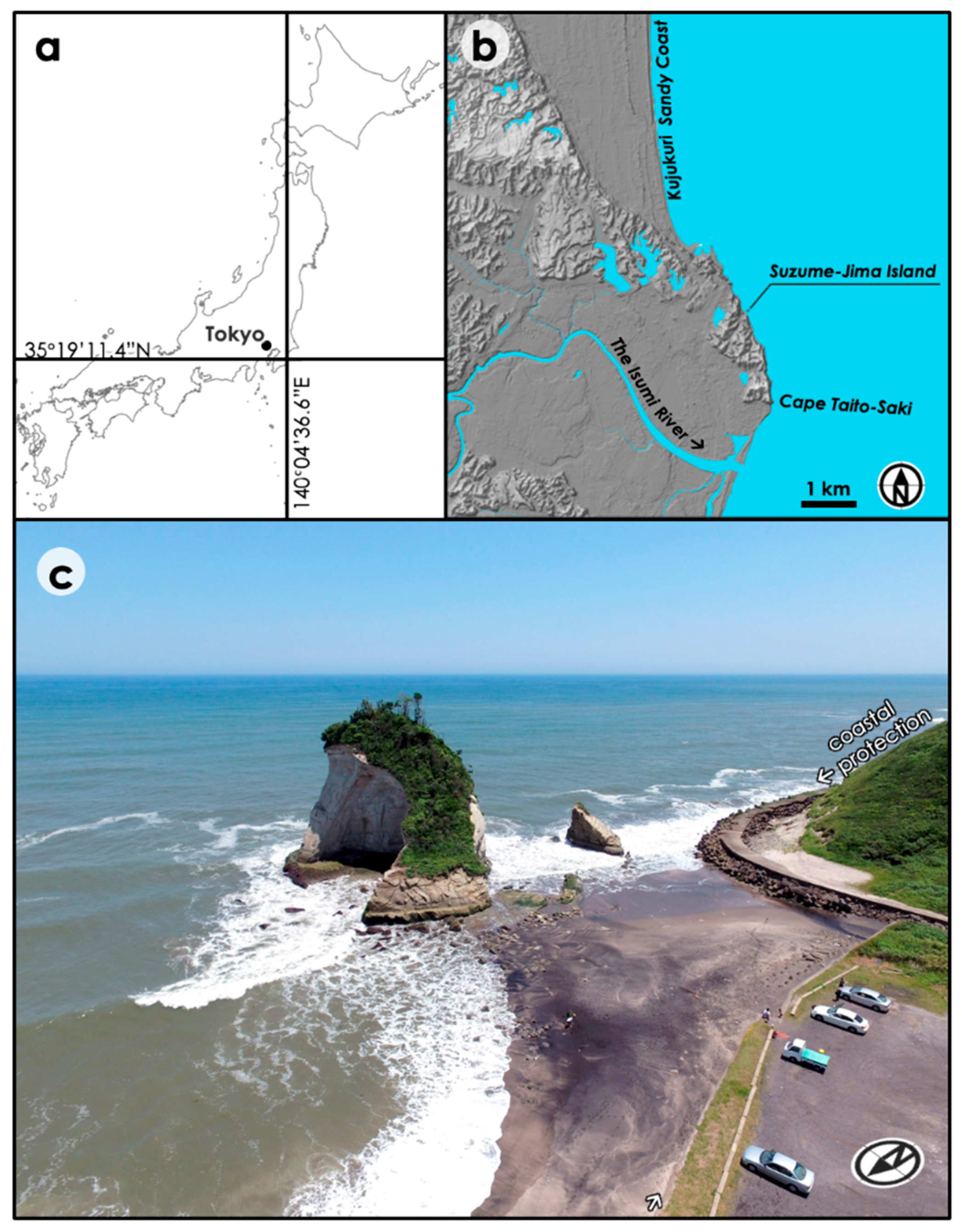
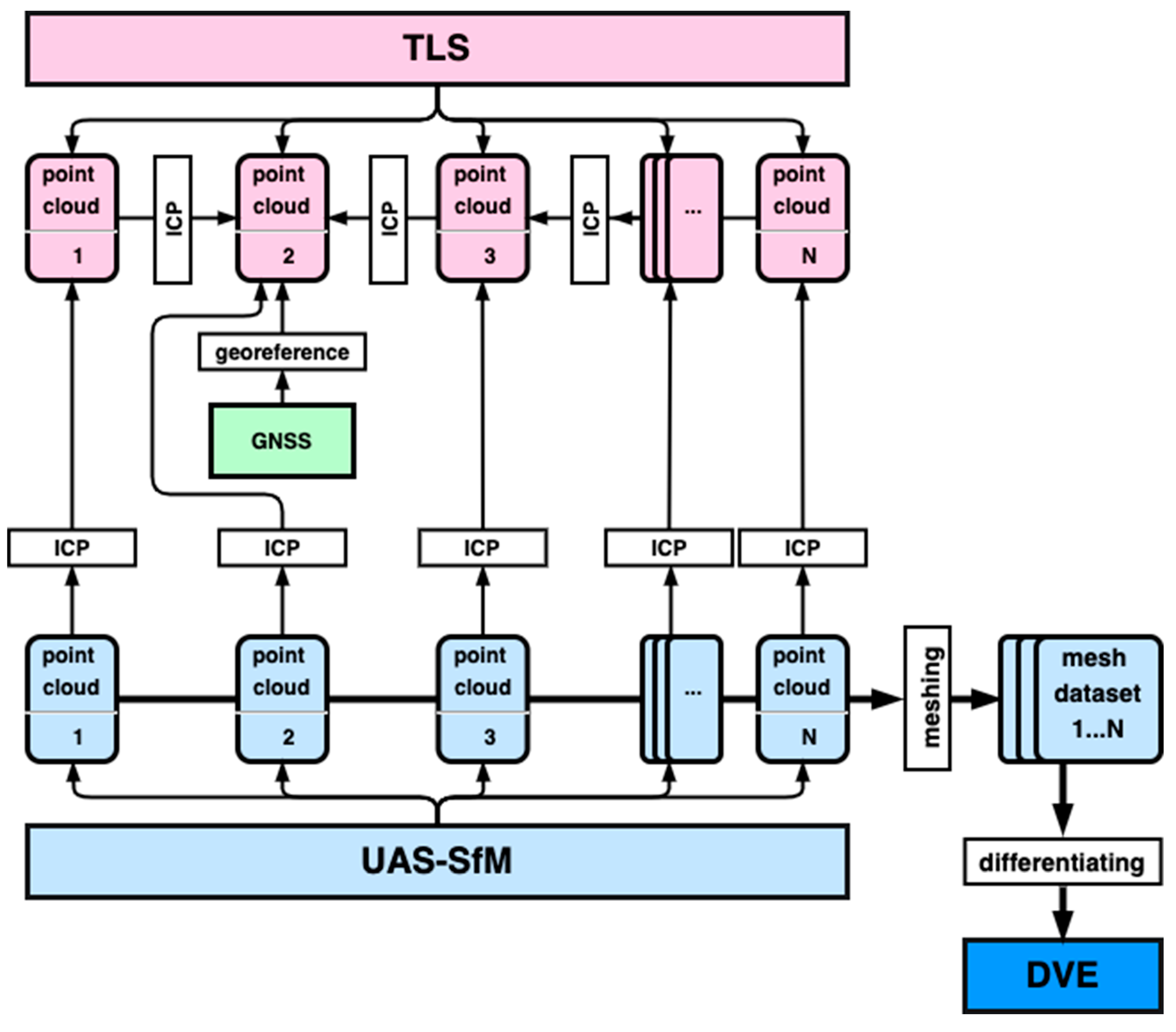
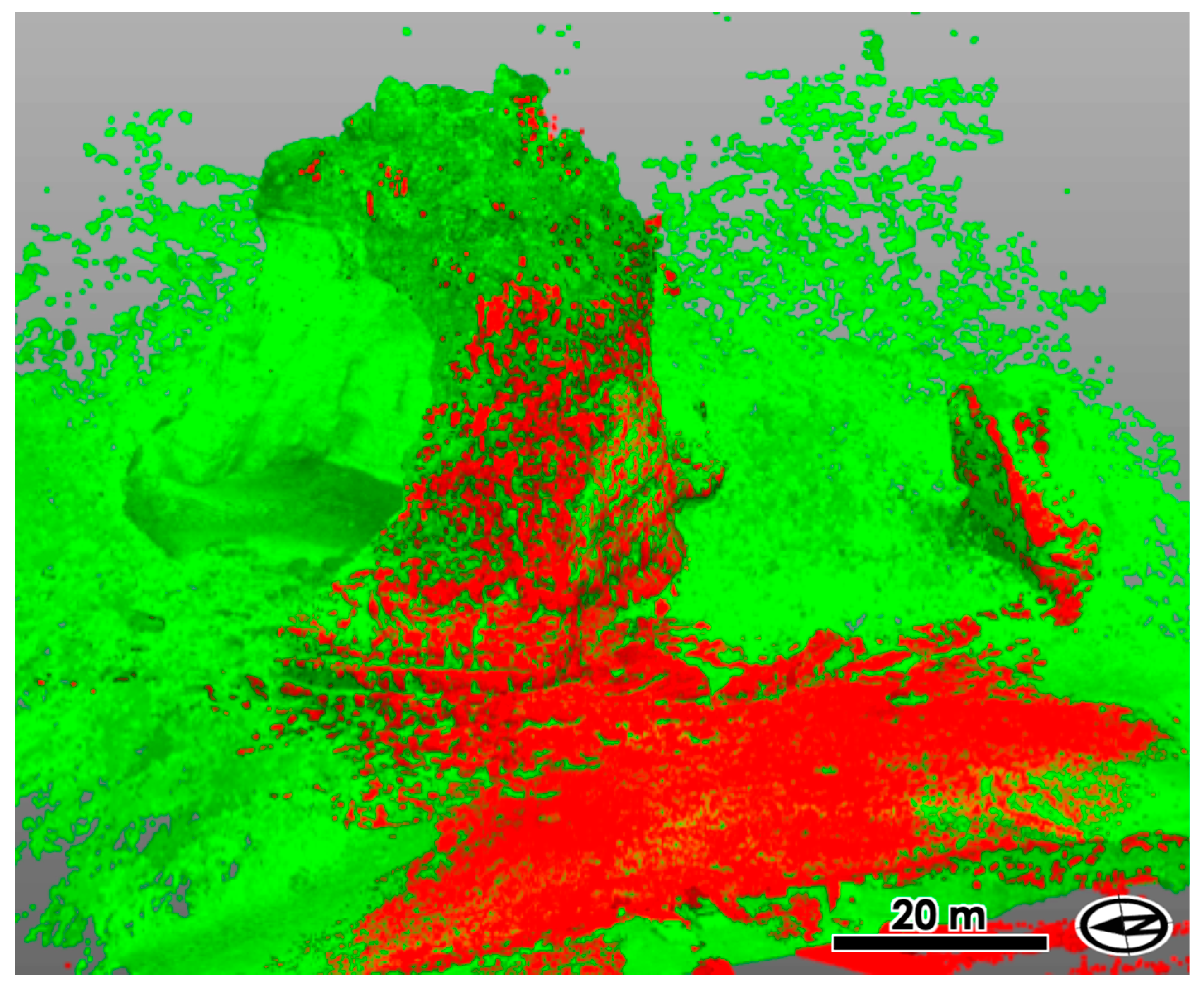
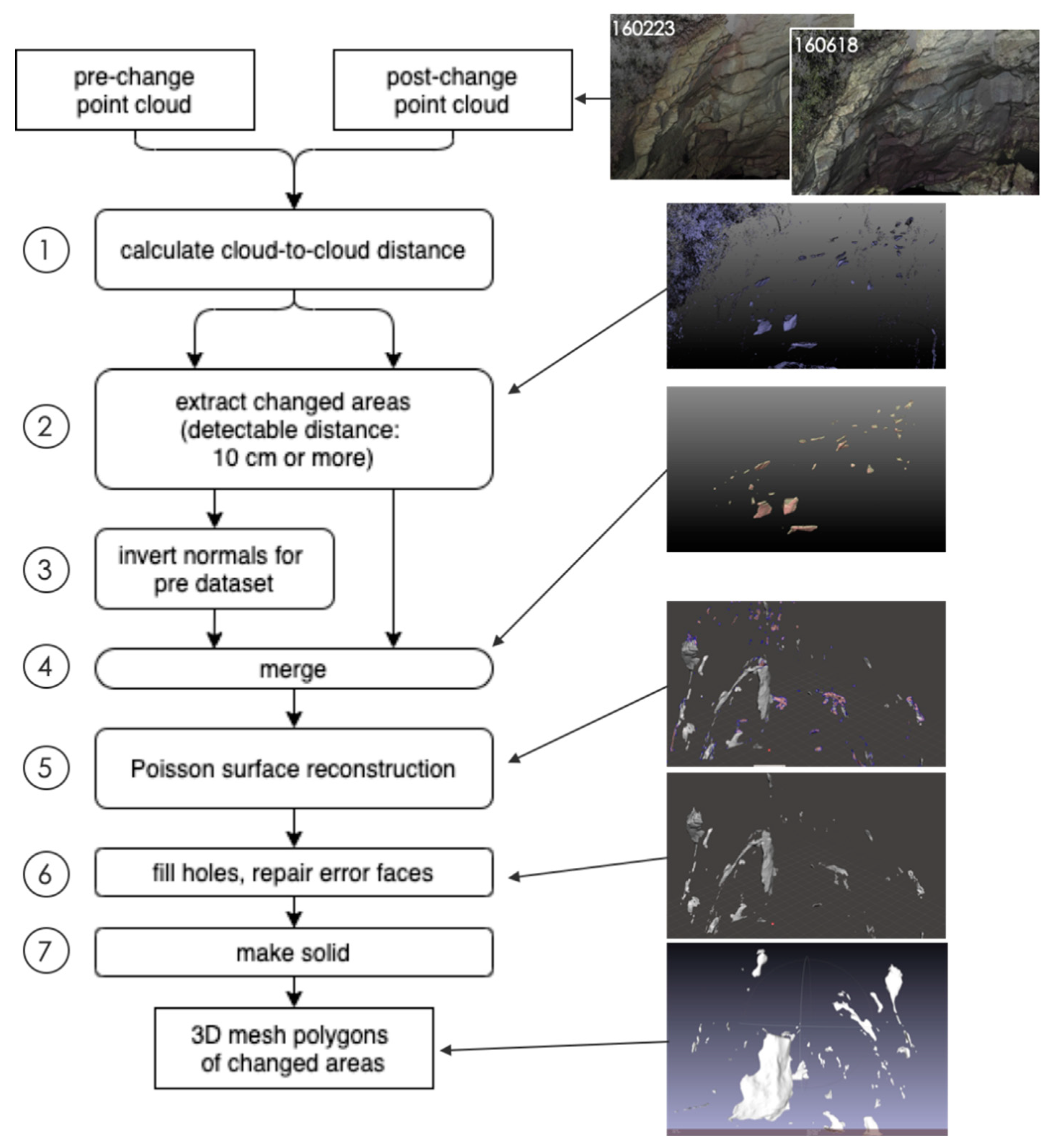

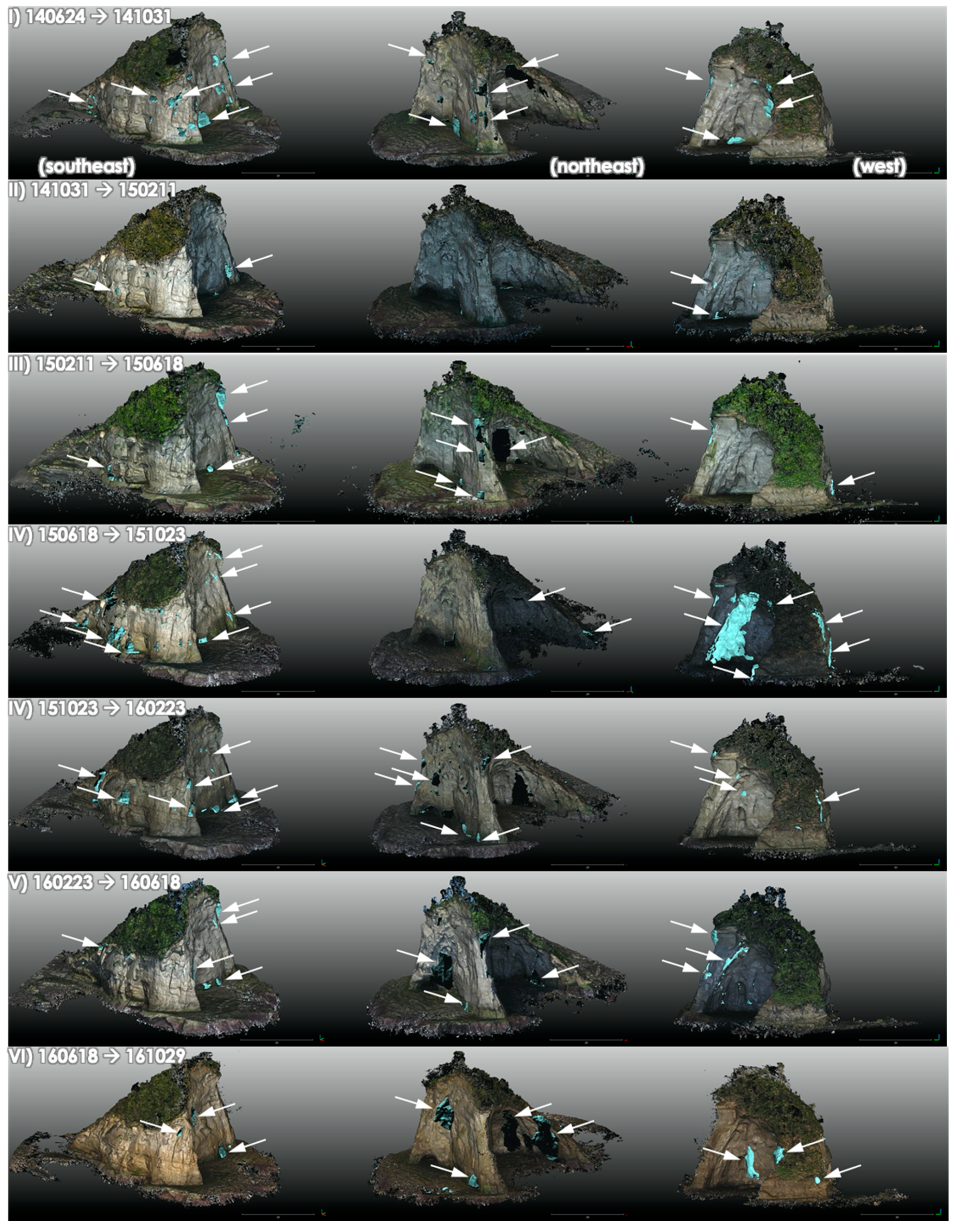
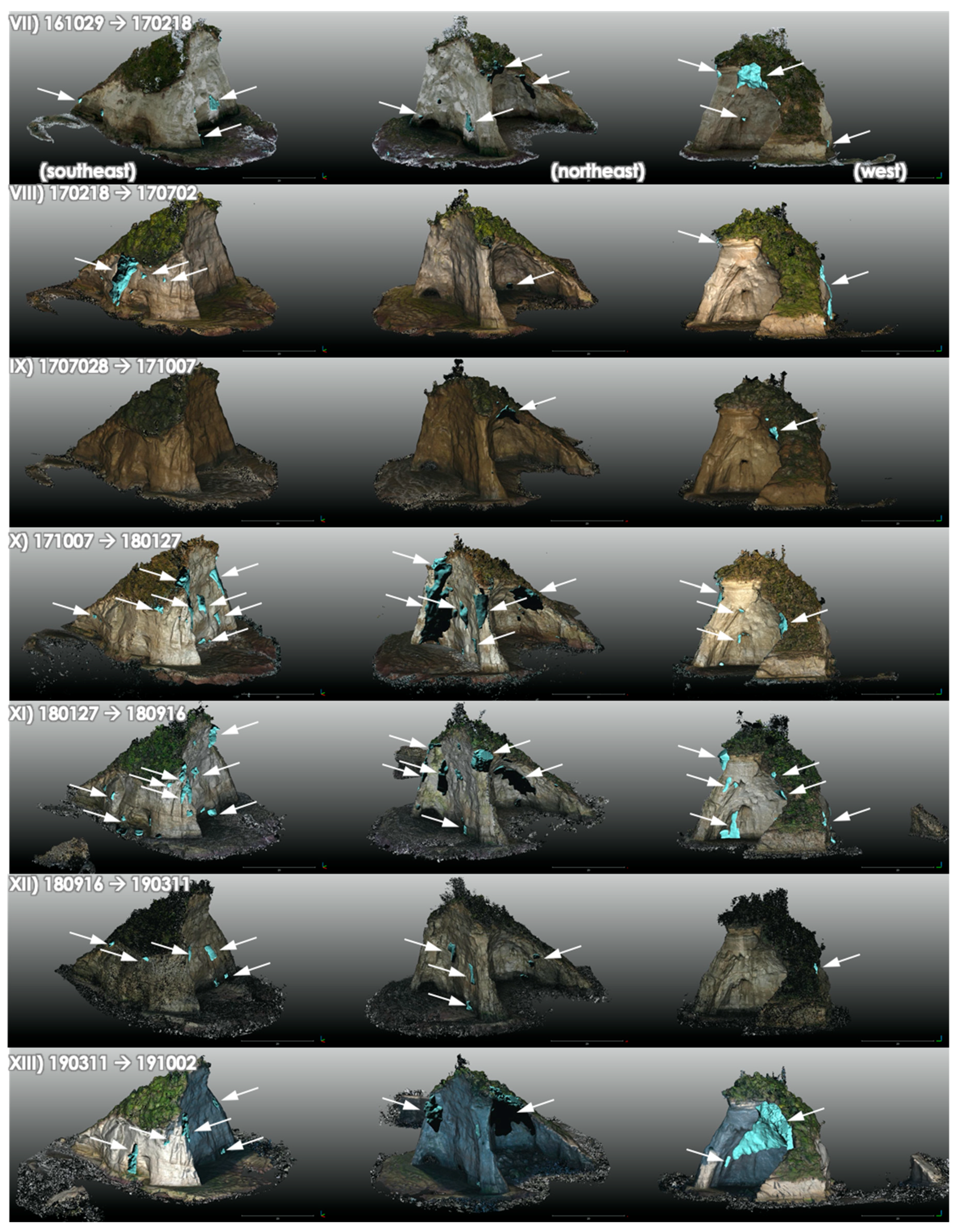
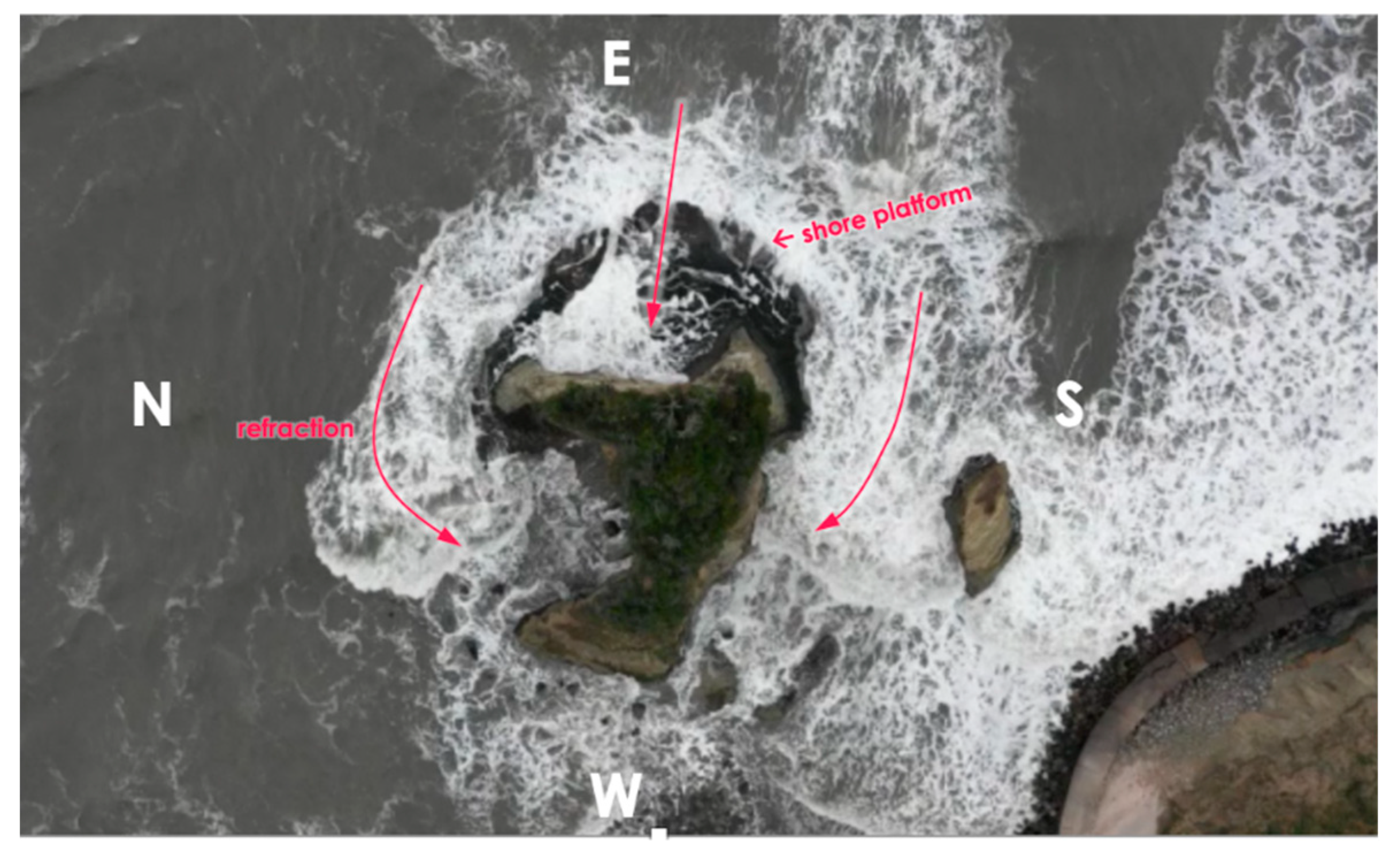
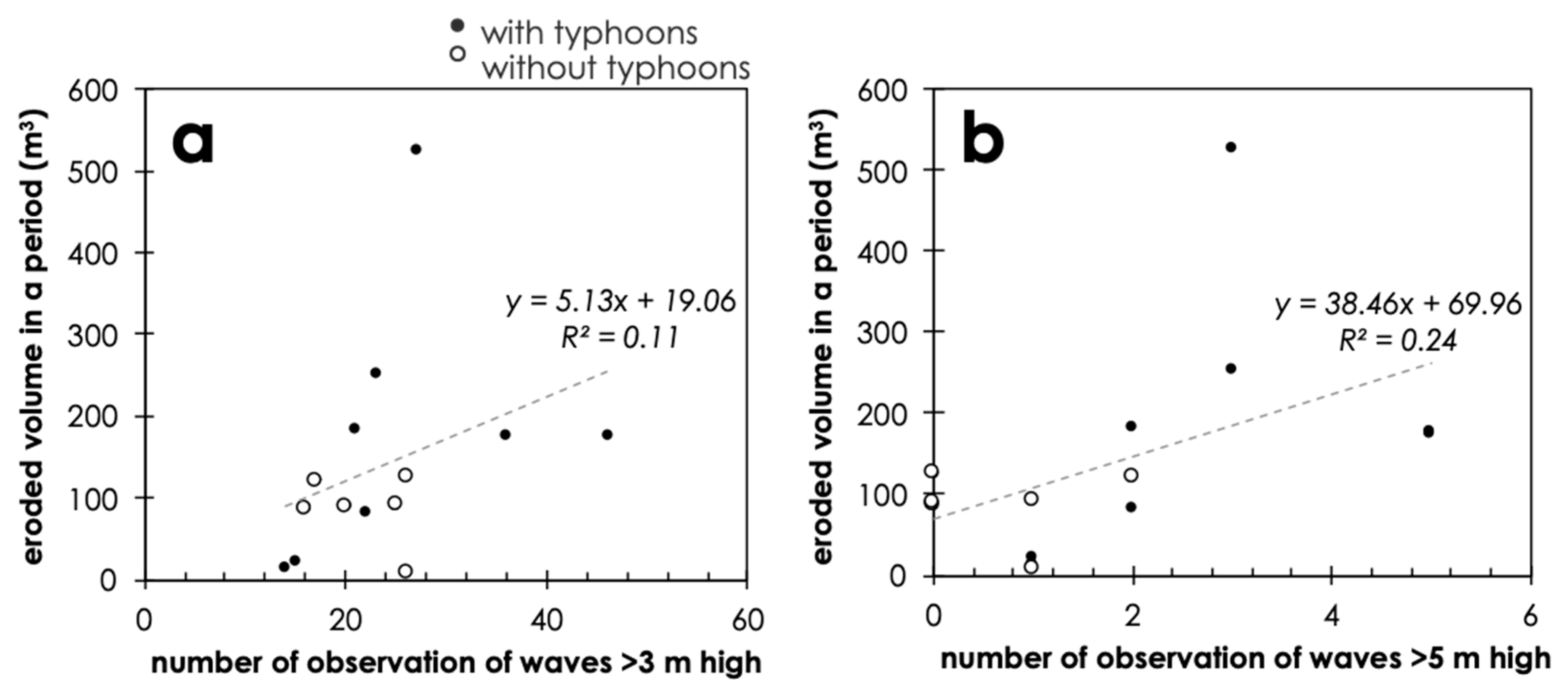
| Num | Period | Name of Dataset | Date of Measurement | Duration (Days) | Number of Tyhoon Attacks | TLS Used | UAS Used | Number of TLS Scan Position | Internal Registration Errors for TLS (mm) | Georeference Errors (mm) | External Registration Errors (mm) | UAS to TLS Registration Errors (mm) | Eroded Volume (m3) | Volume per Month (m3) | Erosion Rates (m/y) | |
|---|---|---|---|---|---|---|---|---|---|---|---|---|---|---|---|---|
| 1 | – | 140624 | 24 June 2014 | – | GLS | Phantom 2 | 1 | – | – | 13.9 | 33.5 | – | – | – | ||
| 2 | I | 141031 | 31 October 2014 | 129 | 1 | – | Phantom 2 | – | – | – | 18.8 | * | – | 84.8 | 19.7 | 0.161 |
| 3 | II | 150211 | 11 February 2015 | 103 | TX5 | Phantom 2 | 10 | 5.3 | – | 21.2 | 39.7 | 10.6 | 3.1 | 0.025 | ||
| 4 | III | 150618 | 18 June 2015 | 127 | TX5 | Phantom 2 | 6 | 3.5 | – | 8.1 | 24.6 | 127.5 | 30.1 | 0.247 | ||
| 5 | IV | 151023 | 23 October 2015 | 127 | 1 | GLS/TX5 | Phantom 3 Pro | 4 | 12.0 | – | 6.4 | 30.1 | 178.5 | 42.2 | 0.345 | |
| 6 | V | 160223 | 23 February 2016 | 123 | GLS/TX5 | Phantom 3 Pro | 6 | 15.9 | 4.2 | – | 25.1 | 92.3 | 22.5 | 0.184 | ||
| 7 | VI | 160618 | 18 June 2016 | 116 | GLS/TX5 | Phantom 3 Pro | 8 | 14.3 | – | 10.6 | 30.2 | 87.9 | 22.7 | 0.186 | ||
| 8 | VII | 161029 | 29 October 2016 | 133 | 4 | GLS/TX5 | Phantom 3 Pro | 5 | 28.1 | – | 25.0 | 33.9 | 185.4 | 41.8 | 0.342 | |
| 9 | VIII | 170218 | 18 February 2017 | 112 | GLS/TX5 | Phantom 3 Pro | 7 | 28.1 | – | 11.0 | 30.5 | 90.6 | 24.3 | 0.199 | ||
| 10 | IX | 170702 | 2 July 2017 | 134 | GLS/TX5 | Phantom 4 | 6 | 21.1 | – | 19.1 | 32.1 | 121.8 | 27.3 | 0.223 | ||
| 11 | X | 171007 | 7 October 2017 | 97 | 1 | GLS | Phantom 4 | 2 | 31.5 | – | 16.7 | 32.0 | 17.0 | 5.3 | 0.043 | |
| 12 | XI | 180127 | 27 January 2018 | 112 | 1 | – | Phantom 4 | – | – | – | 35.9 | * | – | 254.2 | 68.1 | 0.557 |
| 13 | XII | 180916 | 16 September 2018 | 232 | 1 | GLS | Mavic 2 Pro | 2 | 30.9 | – | 22.9 | 32.1 | 176.6 | 22.8 | 0.187 | |
| 14 | XIII | 190311 | 11 March 2019 | 176 | 1 | – | Mavic 2 Pro | – | – | – | 33.6 | * | – | 24.6 | 4.2 | 0.034 |
| 15 | XIV | 191002 | 2 October 2019 | 205 | 1 | TX5 | Mavic 2 Pro | 4 | 2.7 | – | 23.4 | 35.9 | 527.7 | 77.2 | 0.632 | |
| RMS | 20.5 | 20.8 | 31.9 | |||||||||||||
| total | 1,979.5 | |||||||||||||||
| mean | 141.4 | 29.4 | 0.241 | |||||||||||||
| standard deviation | 126.6 | 21.2 | 0.173 | |||||||||||||
| maximum | 31.5 | 35.9 | 39.7 | 527.7 | 77.2 | 0.632 | ||||||||||
| minimum | 2.7 | 6.4 | 24.6 | 10.6 | 3.1 | 0.025 | ||||||||||
| *UAS to UAS | ||||||||||||||||
© 2020 by the authors. Licensee MDPI, Basel, Switzerland. This article is an open access article distributed under the terms and conditions of the Creative Commons Attribution (CC BY) license (http://creativecommons.org/licenses/by/4.0/).
Share and Cite
Hayakawa, Y.S.; Obanawa, H. Volumetric Change Detection in Bedrock Coastal Cliffs Using Terrestrial Laser Scanning and UAS-Based SfM. Sensors 2020, 20, 3403. https://doi.org/10.3390/s20123403
Hayakawa YS, Obanawa H. Volumetric Change Detection in Bedrock Coastal Cliffs Using Terrestrial Laser Scanning and UAS-Based SfM. Sensors. 2020; 20(12):3403. https://doi.org/10.3390/s20123403
Chicago/Turabian StyleHayakawa, Yuichi S., and Hiroyuki Obanawa. 2020. "Volumetric Change Detection in Bedrock Coastal Cliffs Using Terrestrial Laser Scanning and UAS-Based SfM" Sensors 20, no. 12: 3403. https://doi.org/10.3390/s20123403
APA StyleHayakawa, Y. S., & Obanawa, H. (2020). Volumetric Change Detection in Bedrock Coastal Cliffs Using Terrestrial Laser Scanning and UAS-Based SfM. Sensors, 20(12), 3403. https://doi.org/10.3390/s20123403






